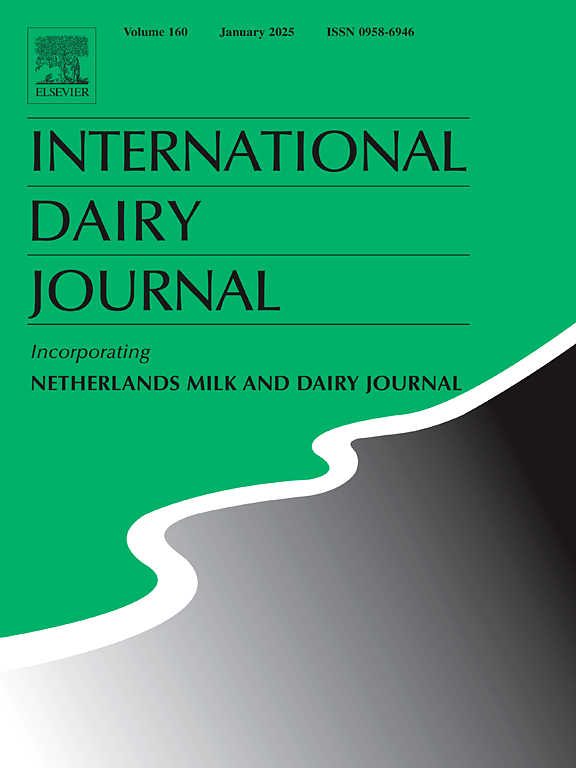非发酵乳清和博拉氏酵母发酵乳清的比较分析:肽组学分析,硅生物活性肽分析,血清蛋白和免疫反应的体内评价
IF 3.1
3区 农林科学
Q2 FOOD SCIENCE & TECHNOLOGY
引用次数: 0
摘要
博拉氏酵母发酵乳清促进了具有功能特性的生物活性肽的释放。本研究采用硅片法和体内法评估了发酵乳清中多肽的抗氧化和抗炎潜力。发酵乳清进行体外消化,然后进行肽组学分析。生物信息学工具在消化的非发酵乳清中鉴定出292条肽,在消化的发酵乳清中鉴定出715条肽,其中预测抗炎的比例更大(40%对50%)。在体内试验中,15只猫分别添加发酵乳清和非发酵乳清,为期20天。治疗组IgA显著升高(8.71 ~ 15.3 mg dL−1,p <;0.05),白细胞水平稳定,单核细胞计数较高(0.65 ~ 0.90 × 103 μL),铁蛋白浓度保持不变,而对照组白细胞变化较大,铁蛋白含量降低(17.0 ~ 12.8 μL−1)。这些结果表明,发酵提高了乳清的生物活性,增强了其作为免疫和炎症调节功能成分的潜力。本文章由计算机程序翻译,如有差异,请以英文原文为准。
Comparative analysis of non-fermented and Saccharomyces boulardii-fermented whey: Peptidomic profiling, in silico bioactive peptide analysis, and in vivo evaluation of serum proteins and immune response
Fermentation of whey with Saccharomyces boulardii enhances the release of bioactive peptides with functional properties. This study assessed the antioxidant and anti-inflammatory potential of peptides from fermented whey using in silico and in vivo methodologies. Fermented whey underwent in vitro digestion, followed by peptidomic analysis. Bioinformatics tools identified 292 peptides in digested non-fermented whey and 715 peptides in digested fermented whey, with a greater proportion predicted as anti-inflammatory (40% vs. 50%). In the in vivo experiment, 15 cats were supplemented with either fermented or non-fermented whey for 20 days. The treated group showed a significant increase in IgA (8.71–15.3 mg dL−1, p < 0.05), stable leukocyte levels, higher monocyte counts (0.65–0.90 × 103 μL), and maintained ferritin concentrations, whereas the control group exhibited greater leukocyte variation and a ferritin decrease (17.0–12.8 μg L−1). These results indicate that fermentation enhances whey's bioactivity, reinforcing its potential as a functional ingredient for immune and inflammatory regulation.
求助全文
通过发布文献求助,成功后即可免费获取论文全文。
去求助
来源期刊

International Dairy Journal
工程技术-食品科技
CiteScore
6.50
自引率
9.70%
发文量
200
审稿时长
49 days
期刊介绍:
The International Dairy Journal publishes significant advancements in dairy science and technology in the form of research articles and critical reviews that are of relevance to the broader international dairy community. Within this scope, research on the science and technology of milk and dairy products and the nutritional and health aspects of dairy foods are included; the journal pays particular attention to applied research and its interface with the dairy industry.
The journal''s coverage includes the following, where directly applicable to dairy science and technology:
• Chemistry and physico-chemical properties of milk constituents
• Microbiology, food safety, enzymology, biotechnology
• Processing and engineering
• Emulsion science, food structure, and texture
• Raw material quality and effect on relevant products
• Flavour and off-flavour development
• Technological functionality and applications of dairy ingredients
• Sensory and consumer sciences
• Nutrition and substantiation of human health implications of milk components or dairy products
International Dairy Journal does not publish papers related to milk production, animal health and other aspects of on-farm milk production unless there is a clear relationship to dairy technology, human health or final product quality.
 求助内容:
求助内容: 应助结果提醒方式:
应助结果提醒方式:


